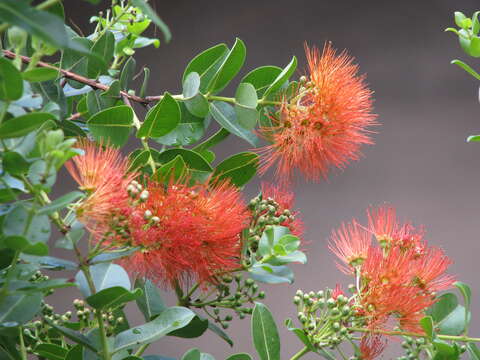Metrosideros polymorpha

Description:
hia, hia lehua, Lehua alaniMyrtaceae (Myrtle family)Endemic to the Hawaiian IslandsOahu (Cultivated)Early Hawaiians fashioned the exceptionally hard wood into kapa beaters, prepping boards for kapa (lau kahi wauke), poi boards (papa kui poi), musical instruments, idols, spears, mallets, standards of khili, house construction, gunwales and interior framework for canoes.The wood was also a superior fire wood.A mixture of hia flowers, the inner bark of the Polynesian-introduced hau (Hibiscus tiliaceus), and a little water were given to women in labor when childbirth pangs became intense. Each time the woman had severe pains she was given a mouthful to drink. The liko (new leaves) would be pounded together with lama leaves, leaf buds and flowers to treat thrush in children. To the mixture was added poi (poi lehua) from kalo lehua, heated with hot stones, then cooled and strained before given to the child. Liko were also used to stimulate the appetite and digestion of a weakened child. Kaluna M. Kaaiakamanu, in his third volume, specifically mentions the use "Metrosideros collina plym Glaberrima" in the aforementioned treatment, but states that the "mother chews the liko," as well pounding methods, before administering it to the baby.From early Hawaii to the present day, flowers, seed capsules and liko (new leaves) have been used for lei working. Lei hia, with or without other material, were given names such as lei lehua ula (red flowers), lei lehua alani (orange flowers), lei lehua melemele (yellow flowers), and lei liko lehua, made with new leaves.The very hard, strong wood is much prized today for flooring, furniture, decorative poles, carvings, and ukulele keys. Sapwood is pale brown, grading gradually into reddish-brown heartwood. Wood takes a fine polish, but is difficult to cure.Beautiful lei made with the flowers, buds and liko are still a favorite as they were among the early Hawaiians.Leaves are used for a pleasant tea in folk remedies.Because of the abundance of nectar, the plants are classed as a honey plant. Lehua or hia honey (meli) has a unique flavor to it.EtymologyThe generic name Metrosideros is derived from the Greek metra, heartwood, and sideron, iron, referring to the very hard wood of these plants.The specific epithet polymorpha, is from the Greek poly, many, and morphos, forms, in reference to the numerous forms or shapes of this species.nativeplants.hawaii.edu/plant/view/Metrosideros_polymorpha
Included On The Following Pages:
- Life (creatures)
- Cellular (cellular organisms)
- Eukaryota (eukaryotes)
- Archaeplastida (plants)
- Chloroplastida (green plants)
- Streptophyta
- Embryophytes
- Tracheophyta (ferns)
- Spermatophytes (seed plants)
- Angiosperms (Dicotyledons)
- Eudicots
- Superrosids
- Rosids
- Myrtales (Myrtle Order)
- Myrtaceae (myrtles)
- Metrosideros (lehua)
- Metrosideros polymorpha ('ohi'a lehua)
This image is not featured in any collections.
Source Information
- license
- cc-by-nc-sa
- copyright
- David Eickhoff
- photographer
- David Eickhoff
- original
- original media file
- visit source
- partner site
- Flickr Group
- ID


